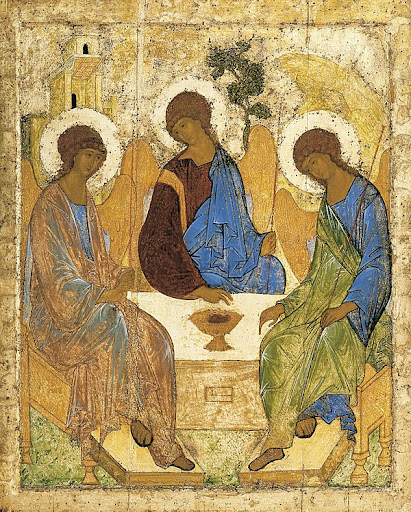

The oneness of God presented a new mystery to the earliest Christians because God the Father was clearly God. But Jesus also identified himself as God (John 8:58). And the Holy Spirit is God (Acts 5:3-4). How can there be one God, when these three “persons” are God?
The Church wrestled with this mystery for several centuries. In the end, Christianity affirmed everything that needed affirmed without trying to give an explanation that is beyond our human comprehension. We affirm that there is only one God. We affirm that one God exists in three persons–Father, Son, and Holy Spirit. They share one divine substance and nature, but they are three distinct persons.
Each person of the Trinity “indwells” and shares in the life of the others. They exist in perfect unity and cooperation. They work together in perfect harmony.
Historical and Scriptural Foundations
Many have found hints of the Trinity in the Old Testament. In Genesis 1:26, God says, “Let us make humanity in our image.” Many have found in the “us” a hint of the Trinity. Some have wondered if the pre-existent Jesus made some appearances in the Old Testament, such as when the Angel or Messenger of the LORD appeared to Moses at the burning bush (cf. John 8:58). The Spirit of the LORD is mentioned several times in the Old Testament (e.g., Gen. 1:2; Isaiah 61:1)
God the Father, Son, and Holy Spirit are mentioned together several times in the New Testament. The Great Commission in Matthew 28:19 urges Jesus’ followers to “Go and make disciples of all nations, baptizing them in the name of the Father and of the Son and of the Holy Spirit.” At the baptism of Jesus in Mark 1:9-11, all three persons of the Trinity are present and active. 2 Corinthians 13:14 presents a benediction on the Corinthians that invokes all three persons.
In the end, Scripture affirms that all three persons are God and that they are distinct persons. In John 10:30, Jesus says, “I and the Father are one.” In return, God the Father calls Jesus his Son in Matthew 17:5: “This is my Son, whom I love; with him I am well pleased.” The Holy Spirit is implied to be a distinct person in John 14. The Spirit is our advocate and helper (John 14:16-17). The Spirit was involved in creation and empowers believers (Genesis 1:2; Acts 2:1-4).
Practical Implications for Believers
Each member of the Trinity seems to play distinct roles in relation to the creation, although they all share the same nature, knowledge, and power. The Father is the ultimate Creator and Sustainer. The Son played the focal role in our redemption and salvation. The Holy Spirit continues to guide, empower, and transform us as believers.
The Trinity is a mystery beyond our comprehension. We cannot understand it. After all, it would be curious if our finite human minds could fully comprehend an infinite, transcendent God whose existence reaches beyond the universe!
Nevertheless, there are clear implications for our lives and worship. The unity and perfect harmony of the persons of the Trinity are a model for us in the Church. They are a call to unity among us, that we might be one as they are one. Additionally, in worship we are not simply worshipping God the Father, but the Son and Spirit as well. We should worship God in the fullness of who God is.